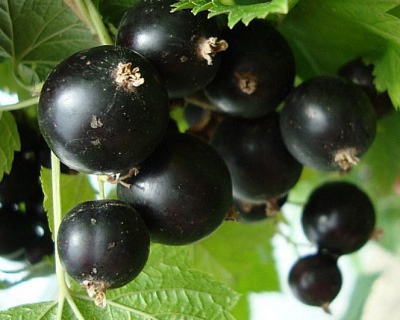
- Authors: Ogoltsova T.P., Knyazev S.D. (FGBNU VNII Selection of fruit crops)
- Appeared when crossing: from pollination of the form (Belorusskaya sweet x Sunderbyun-2) with the Chudesnitsa variety
- Year of approval: 2007
- Ripening terms: average ripening
- Growth type: medium-sized
- Appointment: universal
- Berry weight, g: 1,7
- Tasting assessment: 4,8
- Escapes: growing - green, not pubescent, not colored; lignified - medium, curved, light gray with a light brown top, shiny
- Sheet: medium, dark green, five-lobed, with a bare shiny wrinkled concave plate, with sharp teeth
Currant Temptation is a popular variety among Russian gardeners, which is distinguished by rich black berries that have an excellent taste and nutritional composition. It is worth considering in more detail the key characteristics of the variety and the nuances of its cultivation.
Breeding history
The variety was bred by breeders Ogoltsov and Knyazev. Experts have mixed together the currant Chuddesnitsa and the form (Belorusskaya sweet x Sunderbyun-2). The result was the variety Temptation, officially registered in the country's register in 2007.
Description of the variety
A feature of the Temptation shrub is a dense hibiscus. The height of the variety is standard, its compact size makes it easy to cultivate and allows you to grow it even in small areas.
Other characteristics of currants:
thin branches of light green color;
corrugated edges at the leaves;
heavy foliage;
notch at the base of the leaf;
large flowers;
medium-sized brush.
Each bush has more than 800 flowers.
Characteristics of berries
Currant Temptation gives round large berries. The mass of one fruit reaches 1.5-3 g, the color is rich dark brown or even black. Each berry contains a huge amount of nutrients, so currants are often used to prepare medicines.
Taste qualities
Currant fruits Temptation are distinguished by a rich sugar taste, accompanied by a slight sourness. The pulp is juicy, the rind is thin and tender.
Ripening and fruiting
The variety belongs to the mid-ripening group, ripens after the early currants. The shrub gives its first fruits in the middle of summer.

Yield
The average yield is 1.4 kg per bush. It will be possible to harvest 9.6 tons of juicy berries from 1 hectare.
Self-fertility and the need for pollinators
The variety is self-fertile. In the absence of pollinators, the plant is able to pollinate itself on its own. The presence of pollinators increases yields.
Landing
The best period for planting currants on the site is autumn or early spring. It is important that the buds have not yet blossomed on the bush. For planting, it is better to choose loose, drained soils so that the bush subsequently gives a bountiful harvest.
Before planting, it is recommended to mark on the site a strip up to a meter wide, along which bushes will be planted.It should go from south to north. For each square meter, you will need to pour 2 buckets of compost for the plant to take root quickly. If desired, the compost can be mixed with a glass of wood ash and nitroammofoska in the amount of 150 g.
At the end, the strip is dug so that the soil mixes with the fertilizer. Basic recommendations for planting currants.
The root collar should go 7-10 cm deep.
It is better to plant the bush at an angle of 45 degrees.
The distance between the seedlings should be at least 1.5 meters.
Between the rows, you need to maintain a distance of 2.5-3 meters.
After planting, thoroughly cover the roots with earth, tamp the soil and water abundantly, and then mulch.
During the period of active growth and flowering, branches close to the ground should be cut off. In the third year, care must be taken to remove old and dry branches. Pruning should be done in the spring and fall.
Currant Temptation grows well with other varieties and gives an excellent harvest. Gardeners often plant shrubs next to Viksne or the Black Prince.

Growing and caring
A competent approach to growing currants Temptation will give a bountiful harvest, while the shrub can bear fruit for 10-12 years. Recommendations to help you achieve this result.
Timely watering. The plant tolerates drought well, but in the absence of water at a depth of 40 cm in the required amount, currants may cease to bear fruit. Therefore, it is recommended to water the shrub throughout the summer season.
Pollination. The first buds of the plant open in mid-March, and flowering continues for 7-10 days. If during this period windy and rainy weather is observed, it is worth taking care of additional pollination of the plants.
Top dressing. Especially relevant for currants that grow in hot climates. Fertilization not only accelerates the growth and increases the yield of the variety, but also strengthens the immune system. For feeding, it is better to use formulations with a large amount of trace elements. Among the common ones: "Nutrivant PLUS", "Nutrivant PLUS fruit". It is recommended to apply fertilizers during the growing season.
The correct approach to planting currants will also help ensure high yields. Gardeners advise placing nearby shrubs with different flowering periods.




Disease and pest resistance
The variety is resistant to most diseases and pests. Currants are not afraid:
powdery mildew;
anthracnose;
septoria;
kidney mite.
In order to prevent and increase the immunity of the shrub, it is recommended to carry out regular processing of the leaves and trunk.

Currant is one of the most favorite crops of gardeners, it can be found on almost any personal plot. In order for the currant berries to be tasty and large, and the bush itself to be healthy and strong, you should properly care for, treat and protect the plant from harmful insects. It is important to recognize the signs of the disease in a timely manner and begin treatment in the early stages of plant damage.










































































